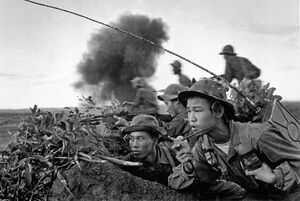Bactieuan Insurgency (Eordisverse)
This article is incomplete because it is pending further input from participants, or it is a work-in-progress by one author. Please comment on this article's talk page to share your input, comments and questions. Note: To contribute to this article, you may need to seek help from the author(s) of this page. |
| Bactieuan Insurgency | |||||||
|---|---|---|---|---|---|---|---|
| Part of the War of Lorican Aggression and Second Lorican-Quenminese War | |||||||
 Troops of the 6th Armored Cavalry Regiment calling in air support during the Battle of Móng Trì and Purtar Creek, 1976 | |||||||
| |||||||
| Belligerents | |||||||
|
| |||||||
| Commanders and leaders | |||||||
| |||||||
The Bactieuan Insurgency (Quenminese: Nổi dậy Bắc Tiêu) was an insurgency waged by the National Front for the Liberation of Bactieu against the Quenminese government for 13 years. Increasing assimilation by the government and discrimination against the Bactieuan indigenous peoples lead to revolts and riots instigated by the National Front's leader Djaja Wira Cahyadi, and the Front's declaration of a Free Bactieu state. Lorica and its allies would offer armament support for the Front.
The rebel group grew in numbers, and eventually controlled the entire eastern half of Bactieu and more than half of the Adelaidine archipelago by 1965. Noting the situation, prime minister Nguyễn Công Thịnh Bảo approved the deployment of 35,000 more Quenminese troops to quell the National Front. The first phase of the war, deemed Bactieu War I, ended in a ceasefire after Bảo's assassination. Đỗ Kim Ngữ would inherit the current situation and propose new agreements to oversee the smooth integration of the peoples in Quenminese society. After Cahyadi and the rest of the leadership refused to acknowledge the proposals, the conflict resumed in 1968, thereby igniting Bactieu War II. As the domestic situation in mainland Quenmin exacerbated, the Quenminese military situation was hindered with attrition, worsened with increasingly confusing military objectives. After Lý Thái Duy's ascension as prime minister, another ceasefire was declared, and Duy initiated talks with the National Front leadership. It once again failed, and the third and final phase of the war, deemed Bactieu War III, started and resulted in the Quenminese gaining the upper hand. By October 1977, most of the National Front's leadership was deceased, and Intan Cinta Setiabudi, the third-in-command, declared the surrender.
The Insurgency's end is commemorated as Tuy Ðec Remembrance Day.